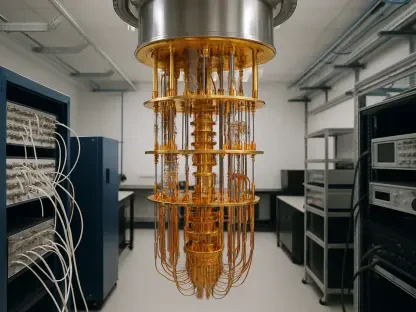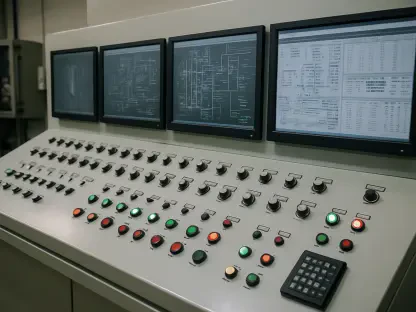In the high-stakes world of military operations, where split-second decisions can determine the outcome of a mission, the complexity of communication systems has long been a formidable challenge, demanding innovative solutions. Across diverse platforms like fighter jets, ground vehicles, and naval vessels, traditional network architectures have relied on multiple segregated systems to manage critical functions such as flight controls, mission data, and diagnostic tools. This fragmented approach, while functional, often results in heavy, costly, and cumbersome infrastructures that are notoriously difficult to upgrade or maintain. Enter Time-Sensitive Networking (TSN), an innovative leap forward in standard Ethernet technology that introduces precise timing capabilities to address these longstanding issues. By offering a unified, intelligent backbone capable of handling diverse data streams with strict timing demands, TSN stands as a transformative force in military communications. This cutting-edge solution not only simplifies system design but also enhances performance under the most demanding conditions. As military needs evolve with increasingly complex and interconnected technologies, TSN emerges as a vital tool to streamline operations, ensuring that critical information flows seamlessly when it matters most. This exploration delves into how TSN is reshaping defense networking, highlighting its origins, unique advantages, and real-world applications in modern warfare.
Unlocking Precision with Deterministic Networking
The cornerstone of TSN’s value in military applications lies in its ability to deliver deterministic communication, a non-negotiable requirement for safety-critical and mission-critical tasks. Unlike standard Ethernet, which can suffer from unpredictable delays, TSN employs advanced mechanisms like time-aware shaping, as defined by IEEE 802.1Qbv, to schedule data transmission in precise, predetermined windows. This ensures that vital information—such as real-time flight control signals or urgent weapons system commands—reaches its destination without interference from less pressing traffic. In scenarios where even a millisecond of jitter could lead to catastrophic outcomes, this precision provides a level of reliability that traditional systems struggle to match. By prioritizing time-sensitive data, TSN creates a robust framework that supports the intense demands of combat environments, whether coordinating air strikes or managing battlefield sensors.
Beyond its timing accuracy, TSN offers the remarkable ability to manage multiple data types on a single network without sacrificing performance. This means that while mission-critical operations are guaranteed their dedicated bandwidth, routine communications like administrative updates or video feeds can still operate on the same infrastructure. Such integration eliminates the inefficiencies of maintaining separate channels for every function, allowing military platforms to remain agile and responsive. This dual capability not only enhances operational effectiveness but also reduces the risk of communication bottlenecks during high-pressure situations, ensuring that every piece of data, regardless of priority, finds its place in the network’s flow.
Simplifying Systems through Network Convergence
One of the most compelling benefits of TSN is its capacity to create a converged network, a significant departure from the segregated setups that have long dominated military design. Historically, different functions—ranging from microsecond-critical flight data to high-bandwidth video streaming—required entirely separate networks, leading to increased complexity, weight, and operational costs. TSN disrupts this paradigm by consolidating all traffic onto a single digital backbone, dramatically reducing size, weight, power consumption, and cost, often referred to as SWaP-C metrics. This streamlined approach is particularly valuable in military contexts, where every ounce and watt must be optimized for efficiency, especially in airborne or mobile units where resources are constrained.
The impact of network convergence extends far beyond mere cost savings or physical downsizing. By unifying disparate systems, TSN simplifies maintenance and upgrades, which are often logistical nightmares in traditional setups. A single infrastructure means fewer components to service and a more straightforward path to integrating new technologies as they emerge. This adaptability is crucial in military environments where downtime can compromise readiness or mission success. Moreover, the reduction of redundant hardware minimizes points of failure, enhancing overall system reliability. As defense forces face growing pressure to modernize while managing tight budgets, TSN’s ability to deliver a leaner, more efficient networking solution positions it as an indispensable asset for future-ready architectures.
Adapting Commercial Innovation for Defense Needs
TSN’s journey to military applications began in commercial sectors, notably automotive and industrial automation, where the need for real-time, reliable communication mirrors the stringent demands of defense systems. In these industries, TSN was refined to integrate time-sensitive control data, such as brake systems or factory sensors, with less urgent information like entertainment feeds or administrative logs. This proven track record of handling mixed traffic under strict timing constraints makes TSN a natural fit for military platforms, where safety-critical and routine communications must coexist seamlessly. Industry experts emphasize that this cross-sector foundation not only validates TSN’s robustness but also accelerates its adoption in areas like aerospace, ground vehicles, and sensor fusion.
Further bolstering TSN’s relevance to defense is the active collaboration between military entities and standards organizations to tailor the technology for specific operational needs. Research efforts and partnerships with groups like SAE International are driving the development of specialized profiles to ensure TSN meets the rigorous requirements of combat environments. These initiatives highlight a broader trend of leveraging commercial off-the-shelf solutions to address defense challenges, reducing development risks and costs while speeding up deployment. By building on a technology already tested in high-stakes civilian applications, the military can confidently integrate TSN into its most demanding systems, from avionics to autonomous vehicle networks, ensuring both reliability and innovation.
Seamless Integration with Existing Infrastructure
A standout feature of TSN is its compatibility with legacy systems, a critical consideration given the military’s extensive use of older technologies that cannot be replaced overnight. Through the use of gateways and protocol converters, TSN bridges traditional interfaces like MIL-STD-1553 and ARINC with modern Ethernet networks, facilitating a gradual transition rather than requiring disruptive, wholesale overhauls. This interoperability allows defense platforms to modernize incrementally, preserving operational continuity while introducing cutting-edge capabilities. Such an approach is particularly valuable in budget-constrained environments, where the cost of replacing entire systems can be prohibitive.
Equally important is TSN’s ability to work with commercial off-the-shelf (COTS) Ethernet devices, further enhancing its practicality for military adoption. By shaping incoming traffic to align with time-sensitive requirements, TSN ensures that standard hardware can be incorporated into advanced networks without necessitating modifications. This flexibility supports technology refresh programs by enabling the integration of new and existing components into a cohesive system. As a result, military forces can upgrade communication infrastructures without sacrificing compatibility or performance, striking a balance between innovation and the realities of maintaining long-standing equipment. This pragmatic integration strategy underscores TSN’s role as a bridge between past and future networking needs in defense.
Building Future-Proof Systems with Open Standards
TSN’s alignment with open standards marks it as a forward-thinking solution for military networking, ensuring compatibility and scalability in an era of rapid technological change. As an IEEE-standardized technology, TSN supports key defense initiatives like the Modular Open Systems Approach (MOSA), Sensor Open Systems Architecture (SOSA), and Future Airborne Capability Environment (FACE). These frameworks prioritize vendor-neutral interoperability, minimizing integration risks and costs in multi-vendor environments often encountered in military projects. By adhering to such standards, TSN fosters a collaborative ecosystem where components from different sources can work together seamlessly, a vital factor for complex defense systems.
This commitment to modularity and openness paves the way for adaptable, future-proof architectures that can evolve with emerging threats and technologies. For instance, in SOSA-aligned hardware, TSN often serves as the data plane fabric, enabling time-sensitive sensor data and general IP traffic to share a unified transport layer without conflict. This capability not only enhances system efficiency but also reduces the long-term costs associated with upgrades and redesigns. As the military continues to push for flexible, interoperable solutions to meet dynamic operational demands, TSN’s standards-based approach positions it as a cornerstone of next-generation defense networks, ready to support everything from current missions to unforeseen challenges ahead.
Reflecting on a Transformative Shift
Looking back, the integration of Time-Sensitive Networking into military systems marked a pivotal moment in addressing the inefficiencies of traditional communication architectures. Its ability to deliver precise, deterministic data flow tackled the critical need for reliability in high-stakes environments, ensuring that mission-essential information was never delayed. The consolidation of disparate networks into a single, efficient backbone reduced logistical burdens, while compatibility with legacy and commercial hardware eased the transition to modern standards. Reflecting on this shift, TSN proved to be a catalyst for smarter, more cost-effective designs that aligned with the military’s strategic goals of modularity and interoperability.
Moving forward, the focus should center on expanding TSN’s deployment across diverse platforms, from naval fleets to unmanned systems, to fully harness its potential. Continued collaboration with industry partners and standards bodies will be essential to refine aerospace-specific profiles and address any remaining challenges, such as bandwidth overhead. Investing in training and infrastructure to support widespread adoption will ensure that defense forces can leverage TSN’s benefits without disruption. As new technologies emerge, TSN’s scalable framework offers a foundation to build upon, promising a future where military communications are not just reactive but proactively equipped for evolving demands.









